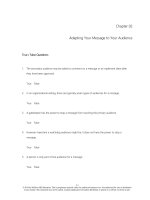Business communication building critical skill 6th module022
Bạn đang xem bản rút gọn của tài liệu. Xem và tải ngay bản đầy đủ của tài liệu tại đây (1007.5 KB, 25 trang )
Finding,
Analyzing, and
Documenting
Information
Module
Twenty Two
McGraw-Hill/Irwin
Copyright © 2014 by The McGraw-Hill Companies, Inc. All rights reserved.
Learning Objectives
LO 22-1 Apply strategies for print and online
information searches.
LO 22-2 Apply strategies for web page
evaluation.
LO 22-3 Apply strategies for survey and
interview question use.
22-2
Learning Objectives
LO 22-4 Identify respondents for surveys
and interviews.
LO 22-5 Analyze information from research.
LO 22-6 Practice common citation styles for
research documentation.
22-3
Types of Research
Primary
Gathers new information.
Includes surveys, interviews, and observations.
Secondary
Retrieves published information.
Includes library research and online searches.
22-4
How can I find information
online and in print?
Keywords
the terms that the computer searches for in a
database or on the web.
At the beginning of a search, use all the
synonyms and keywords you can think of.
22-5
Examples of a Boolean Search
22-6
Sources for Electronic Research
22-7
Sources for Web Research
22-8
Using the Internet for Research
Finding Web pages
Use root words to find variations.
Use quotation marks for exact terms.
Uncapitalize words.
22-9
Using the Internet for Research
Evaluating Web pages
Use reputable sources.
Look for an author.
Check the date and source.
Compare the information with other sources.
22-10
How do I write questions for
surveys and interviews?
A survey questions a large group of people,
called respondents or subjects.
Questionnaire
a written list of questions that people fill out
Interview
a structured conversation with someone who
will be able to give you useful information
22-11
How do I write questions for
surveys and interviews?
When asking questions
Use phrasing that doesn’t bias the response.
Avoid questions that make assumptions about
your audience.
Use words that mean the same thing to you and
your audience.
22-12
How do I write questions for
surveys and interviews?
Closed questions
have a limited
number of possible
responses.
Open questions do
not lock the subject
into any sort of
response
22-13
Closed and Open Questions
22-14
How do I write questions for
surveys and interviews?
Branching questions
direct different respondents to different parts of
the questionnaire based on their answers to
earlier questions.
22-15
How do I decide whom to
survey or interview?
The population is the
group you want to
make statements
about
Defining your
population correctly is
crucial to getting
useful information
22-16
How do I decide whom to
survey or interview?
Random sample
each person in the population theoretically has
an equal chance of being chosen
Convenience sample
a group of respondents who are easy to get
Judgment sample
a group of people whose views seem useful
22-17
How should I analyze the information
I’ve collected?
22-18
Analyzing Words
Have things changed over time?
Does geography account for differences?
What similarities do you see?
What differences do you see?
What confirms your hunches?
What surprises you?
22-19
Checking Your Logic
Causation
means that one thing causes or produces
another.
Correlation
means that two things happen at the same time
22-20
Checking Your Logic
Identify changes that might yield a different
result
Discuss circumstances that may have affected
the results
Summarize your negative findings in progress
reports
Remember that negative results aren’t always
disappointing to the audience
22-21
How should I document sources?
The two most widely used formats for
endnotes and bibliographies in reports are
those of the Modern Language Association
(MLA) and the American Psychological
Association (APA).
22-22
How should I document sources?
Citation
means attributing an
idea or fact to its
source in the body of
the report
Documentation
means providing the
bibliographic
information readers
would need to go back
to the original source
22-23
MLA and APA Formats for
Documenting Sources
22-24
MLA and APA Formats for
Documenting Sources
22-25









